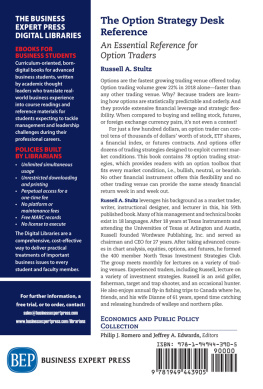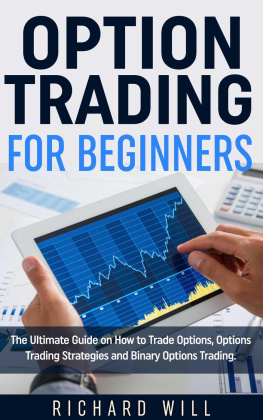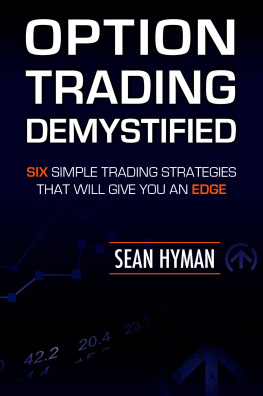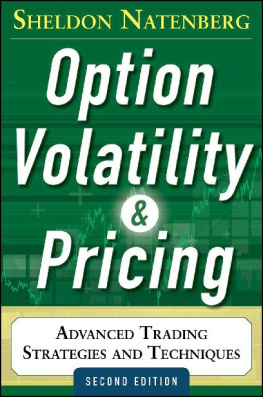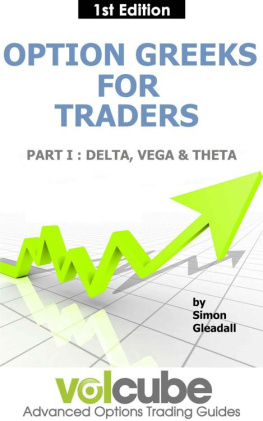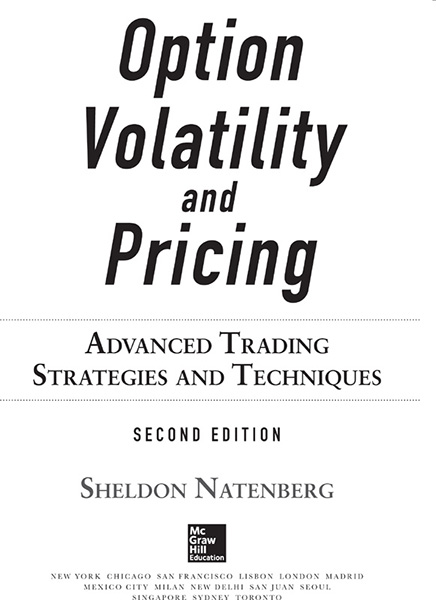Copyright 2015 by Sheldon Natenberg. All rights reserved. Except as permitted under the United States Copyright Act of 1976, no part of this publication may be reproduced or distributed in any form or by any means, or stored in a database or retrieval system, without the prior written permission of the publisher.
ISBN: 978-0-07-181878-0
MHID: 0-07-181878-2
The material in this eBook also appears in the print version of this title: ISBN: 978-0-07-181877-3, MHID: 0-07-181877-4.
eBook conversion by codeMantra
Version 1.0
All trademarks are trademarks of their respective owners. Rather than put a trademark symbol after every occurrence of a trademarked name, we use names in an editorial fashion only, and to the benefit of the trademark owner, with no intention of infringement of the trademark. Where such designations appear in this book, they have been printed with initial caps.
McGraw-Hill Education eBooks are available at special quantity discounts to use as premiums and sales promotions, or for use in corporate training programs. To contact a representative please visit the Contact Us page at www.mhprofessional.com.
TERMS OF USE
This is a copyrighted work and McGraw-Hill Education and its licensors reserve all rights in and to the work. Use of this work is subject to these terms. Except as permitted under the Copyright Act of 1976 and the right to store and retrieve one copy of the work, you may not decompile, disassemble, reverse engineer, reproduce, modify, create derivative works based upon, transmit, distribute, disseminate, sell, publish or sublicense the work or any part of it without McGraw-Hill Educations prior consent. You may use the work for your own noncommercial and personal use; any other use of the work is strictly prohibited. Your right to use the work may be terminated if you fail to comply with these terms.
THE WORK IS PROVIDED AS IS. McGRAW-HILL EDUCATION AND ITS LICENSORS MAKE NO GUARANTEES OR WARRANTIES AS TO THE ACCURACY, ADEQUACY OR COMPLETENESS OF OR RESULTS TO BE OBTAINED FROM USING THE WORK, INCLUDING ANY INFORMATION THAT CAN BE ACCESSED THROUGH THE WORK VIA HYPERLINK OR OTHERWISE, AND EXPRESSLY DISCLAIM ANY WARRANTY, EXPRESS OR IMPLIED, INCLUDING BUT NOT LIMITED TO IMPLIED WARRANTIES OF MERCHANTABILITY OR FITNESS FOR A PARTICULAR PURPOSE. McGraw-Hill Education and its licensors do not warrant or guarantee that the functions contained in the work will meet your requirements or that its operation will be uninterrupted or error free. Neither McGraw-Hill Education nor its licensors shall be liable to you or anyone else for any inaccuracy, error or omission, regardless of cause, in the work or for any damages resulting therefrom. McGraw-Hill Education has no responsibility for the content of any information accessed through the work. Under no circumstances shall McGraw-Hill Education and/or its licensors be liable for any indirect, incidental, special, punitive, consequential or similar damages that result from the use of or inability to use the work, even if any of them has been advised of the possibility of such damages. This limitation of liability shall apply to any claim or cause whatsoever whether such claim or cause arises in contract, tort or otherwise.
To Leona, for her support and encouragement throughout my career.
To Eddie, who continually makes me proud to be a father.
Contents
Preface
It probably seems strange for an author to wait 20 years to revise a professional publication, especially one that has been continuously in print over the entire period. To those of you who were hoping for at least one revision in the intervening years, I can only offer my apology and the excuse that other obligations prevented me from undertaking such a revision.
Much has changed in option markets over the last 20 years. Most markets are now fully electronic, and the days of floor trading are clearly numbered. Only in the United States do option-trading floors still exist, and even those are inevitably giving way to electronic trading. Twenty years ago, organized option markets existed only in the major industrialized nations. But as the importance of derivatives as both an investment vehicle and a risk-management tool has become widely recognized, new option markets have opened in countries around the world. Options are now traded not only on traditional productsstocks, interest rates, commodities, and foreign currenciesbut also on a bewildering array of new productsreal estate, pollution, weather, inflation, and insurance. Many exchanges have also added variations on traditional productsshort-term and midcurve options, flex options, options on spreads, and implied and realized volatility contracts.
Not only has there been a dramatic increase in the number of option markets, but the traders in those markets have become increasingly sophisticated. When this text was first published, knowledgeable traders could only be found at firms that traded derivatives professionallymarket-making firms, hedge funds, investment banks, and other proprietary trading firms. Now, many retail customers have a level of knowledge equal to that of a professional trader. At the same time, universities are adding or expanding programs in financial engineering. In many cases, those who choose a career in derivatives trading have already had in-depth exposure to the mathematics of option pricing.
While much has changed in the last 20 years, much has also remained the same. There is still a core body of material that a serious option trader needs to master, and this core material is much the same as it has always been. The previous edition of this text was an attempt to present this material in a manner that was easily accessible and that did not require a familiarity with advanced mathematics. This edition retains that approach. Although some presentations may have been changed in the interest of improving an explanation or clarifying a concept, all the major topics from the previous edition have been retained.
So whats new in this edition? As in the first edition, an attempt has been made to explain important concepts in the simplest possible manner using an intuitive rather than mathematical approach. However, it is also true that a full understanding of many option concepts requires a familiarity with more advanced mathematics. Consequently, some explanations have been expanded to include a discussion of the relevant mathematics. But even these discussions tend to avoid mathematical concepts with which many readers are unlikely to be familiar. Many chapters have also been expanded to include a more detailed discussion of the relevant topics. In addition, there are several completely new chapters covering forward pricing, risk dynamics, the Black-Scholes model, binomial option pricing, and volatility contracts.
As with any living language, market terminology, and more specifically, option terminology, has changed over time. Some terms that were common when the first edition appeared have gone out of favor or disappeared completely. Other terms that did not previously exist have gained wide acceptance. This is reflected in small changes to the vocabulary used in this text.
It is almost impossible to keep up with the amount of information that is available on options. Not only do new books appear with greater frequency, but the Internet has enabled traders to find relevant source material almost instantaneously. For this reason, the Bibliography has been eliminated. This should not be construed as an attempt to discourage readers from consulting other sources. This book represents only one approach to optionsthat of a professional trader. Many excellent option books are available, and any aspiring option trader will want to consult a broad range of texts in order to understand the many different ways one can approach option markets. For those who are interested in the mathematics of option pricing, this text is in no way meant to take the place of a good university textbook on financial engineering.


